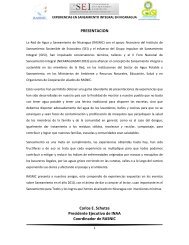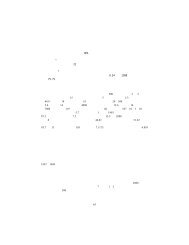Open Planning of Sanitation Systems
Open Planning of Sanitation Systems
Open Planning of Sanitation Systems
You also want an ePaper? Increase the reach of your titles
YUMPU automatically turns print PDFs into web optimized ePapers that Google loves.
Elisabeth Kvarnström and Ebba af Petersens• Does the system start at the boundary <strong>of</strong> the garden or within the bathroom?• Does the system include other houses?• Does the system include treatment or only collection and discharge to a larger system?The system boundary definition is important for cost calculations, the definition <strong>of</strong>responsibilities, and for selecting a sampling point for, if applicable, outgoing wastewater.CASE STUDY: <strong>Sanitation</strong> system boundariesIn Vadsbro, there was an existing system with sewage pipes, pump stations and buildings.Therefore the system boundaries were set from the beginning, but extended to include anoutdoor treatment.STEP 3: TERMS OF REQUIREMENT (TOR)This step has similarities with ‘STEP 4: Assessment <strong>of</strong> user priorities’ in the HCES approach(Schertenleib et al., 2004). The terms <strong>of</strong> requirement (ToR) for assessing sanitation alternativesare usually set by the facilitator together with the stakeholders and in collaboration withlocal government to ensure compliance with regulations. This can be done by using PHAST/SARAR methodology. PHAST tools such as ‘blocking the routes’ can help identify ways toprevent disease propagation. If the project is <strong>of</strong> a larger scale, the ToR can be set in an LFAworkshop.ToR should be comprehensive and include all factors needed to ensure sustainable sanitationin the actual context. The discussion on what is needed for the sanitation to be sustainablecan be inspired by the list provided in Appendix 1. It is, however, extremely important toremember that this criteria list is a suggestion <strong>of</strong> what might be worthwhile to consider, andneeds to be adapted to the actual case.In open planning <strong>of</strong> sanitation systems we choose to organize the function requirementsin two blocks, where the first block contains what could be considered as primary functions,to avoid external effects, <strong>of</strong> a sustainable sanitation system. These primary functions includehygiene, environmental protection and resource conservation.The second block is more geared towards the user, where practical functions such as userfriendliness,reliability and affordability are discussed.These two blocks need to be considered in tandem and a balance between the two needsto be identified. The ToR, with these two blocks, can be compared to a bar for high-jumpers,where the level is set on one side by primary functions and on the other side by practicalconsiderations.Table 1 shows the ToR for Vadsbro village 4 , as developed by the concerned stakeholders(Ridderstolpe, 1999).Each heading in the ToR is explained and discussed below.4 Design # <strong>of</strong> pe: 140; design wastewater flow: 45 m 3 /day (pe = person equivalents)6



![Project Document [PDF: 2.31 MB] - EcoSanRes](https://img.yumpu.com/51279385/1/184x260/project-document-pdf-231-mb-ecosanres.jpg?quality=85)












![Latrines à compost [high-resolution colour PDF: 12.3MB] - EcoSanRes](https://img.yumpu.com/31726141/1/185x260/latrines-a-compost-high-resolution-colour-pdf-123mb-ecosanres.jpg?quality=85)